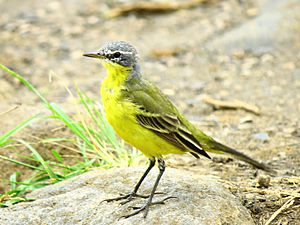Eastern yellow wagtail facts for kids
Quick facts for kids Eastern yellow wagtail |
|
|---|---|
 |
|
| M. t. simillima | |
| Conservation status | |
| Scientific classification | |
| Subspecies | |
|
5, but see text |
|
 |
The eastern yellow wagtail (Motacilla tschutschensis) is a small perching bird. It belongs to the wagtail family called Motacillidae. This family also includes birds like pipits and longclaws.
People often used to think this bird was a type of western yellow wagtail. But now, it is usually seen as its own separate species.
These birds breed in eastern Palearctic regions, which include parts of Europe and Asia. They also breed in North America, specifically in Alaska. When winter comes, these birds migrate to warmer places. They fly to southern Asia and Australia.
Sometimes, these wagtails fly off course. They can be seen in places like Palau in Micronesia during migration. On the Marianas, you might spot a stray bird, usually a female or a young one.
Contents
What Does the Eastern Yellow Wagtail Look Like?
This bird is slender and about 15–16 cm long. It has a long tail that it wags constantly. This wagging tail is a special feature of its bird group.
Adult males in breeding season are mostly olive green on top. Their undersides are bright yellow. In other seasons, or for females and young birds, the yellow color might be lighter or mixed with white. The heads of breeding males can have different colors and patterns. This depends on which subspecies they belong to.
The eastern yellow wagtail makes a distinct, high-pitched sound. It calls out with a jeet sound.
Where Do Eastern Yellow Wagtails Live?
These birds love open areas near water. You can find them in wet meadows, for example. They are insectivores, meaning they eat insects.
Eastern yellow wagtails build their nests in clumps of grass. The female bird usually lays between 4 and 8 eggs. These eggs are speckled with small spots.
Scientists have found a tiny parasite in these birds. It's called Apororhynchus paulonucleatus. This parasite lives in the bird's gut.
Systematics: Different Types of Eastern Yellow Wagtails
The way scientists classify this bird can be a bit confusing. Many different types, or subspecies, have been described over time. Currently, scientists usually agree on about 5 main subspecies.
Some scientists still group the eastern and western yellow wagtails together. They call them simply the yellow wagtail (M. flava).
Current Subspecies of Eastern Yellow Wagtail
Here are the main types of eastern yellow wagtails:
South Siberian Yellow Wagtail
- M. t. angarensis (Sushkin, 1925)
- Males look like a type of western yellow wagtail called M. flava plexa. But they have a clearer stripe above their eye.
- They breed in southern Siberia, stretching to northern Mongolia.
- They spend winter in Southeast Asia.
White-headed Yellow Wagtail
- M. t. leucocephala (Przevalski, 1887)
- Males have a very pale, almost white head.
- Females look like flava females but have a slightly darker head.
- They breed in northwestern Mongolia and nearby parts of China and Russia.
- They likely spend winter in India.
Green-crowned Yellow Wagtail
- M. t. taivana (Swinhoe, 1863)
- Also known as the Kuril yellow wagtail.
- They are darker on top than another type called M. f. flavissima. Their ear areas are very dark, almost black.
- Males and females look similar.
- They breed from Sakhalin to northern Hokkaidō, Japan.
- They spend winter from Myanmar to Taiwan, and south to Wallacea.
Southeast Siberian Yellow Wagtail
- M. t. macronyx (Stresemann, 1920)
- Males are brighter and have stronger markings than M. f. thunbergi.
- Females look like thunbergi females but do not have a stripe above their eye.
- They breed in southeastern Transbaikalia, east to the coast, and south to Manchuria.
- They spend winter northwest of the South China Sea.
Bering Sea Yellow Wagtail
- M. t. simillima Hartert, 1905
- Also known as the short-tailed grey-headed wagtail.
- Both males and females look similar to the M. f. flava type. But their stripe above the eye is usually less clear.
- They breed on the Kamchatka and Bering Sea islands. They might also breed in the Aleuts.
- They spend winter in Southeast Asia, going as far south as northern Australia.
See also
 In Spanish: Lavandera de Chukotka para niños
In Spanish: Lavandera de Chukotka para niños


